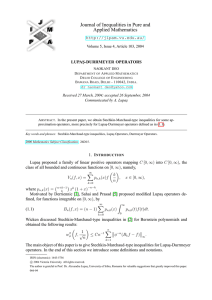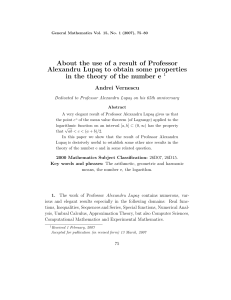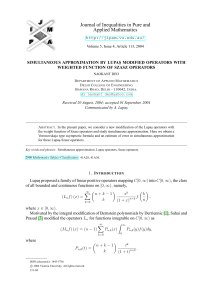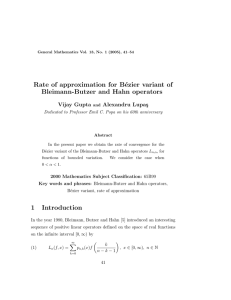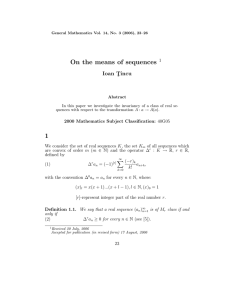π Alexandru Lupa¸s Luciana Lupa¸s
advertisement
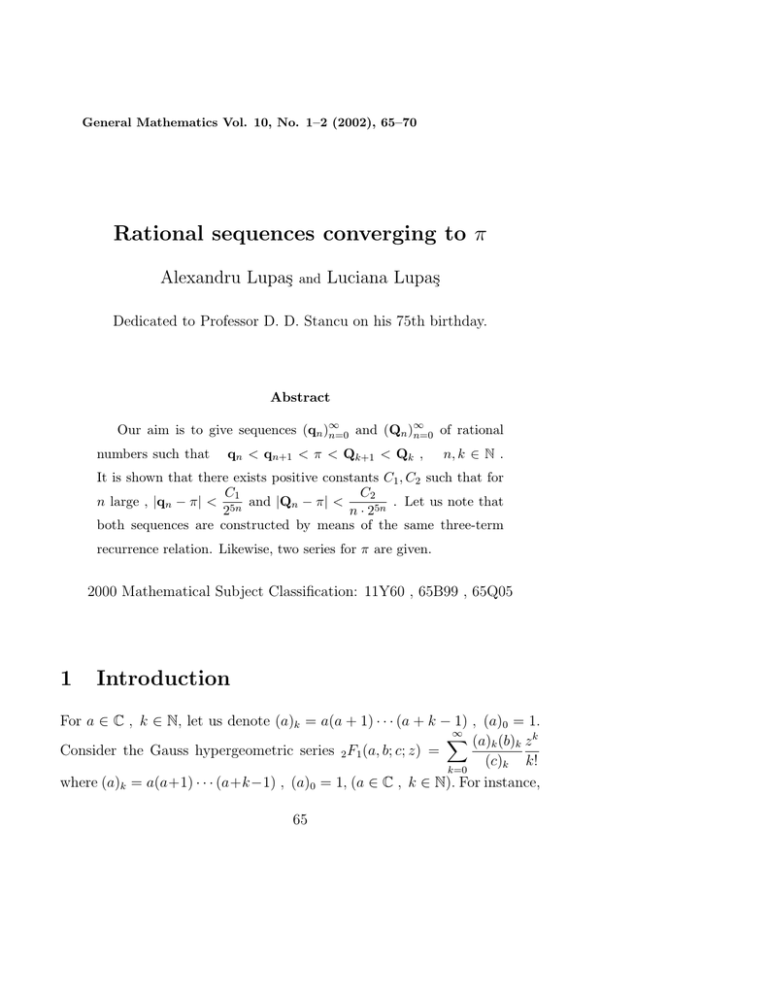
General Mathematics Vol. 10, No. 1–2 (2002), 65–70
Rational sequences converging to π
Alexandru Lupaş
and
Luciana Lupaş
Dedicated to Professor D. D. Stancu on his 75th birthday.
Abstract
∞
Our aim is to give sequences (qn )∞
n=0 and (Qn )n=0 of rational
numbers such that
qn < qn+1 < π < Qk+1 < Qk ,
n, k ∈ N .
It is shown that there exists positive constants C1 , C2 such that for
C1
C2
n large , |qn − π| < 5n and |Qn − π| <
. Let us note that
2
n · 25n
both sequences are constructed by means of the same three-term
recurrence relation. Likewise, two series for π are given.
2000 Mathematical Subject Classification: 11Y60 , 65B99 , 65Q05
1
Introduction
For a ∈ C , k ∈ N, let us denote (a)k = a(a + 1) · · · (a + k − 1) , (a)0 = 1.
∞
X
(a)k (b)k z k
Consider the Gauss hypergeometric series 2 F1 (a, b; c; z) =
(c)k k!
k=0
where (a)k = a(a+1) · · · (a+k−1) , (a)0 = 1, (a ∈ C , k ∈ N). For instance,
65
66
Alexandru Lupaş and Luciana Lupaş
(α,β)
Rn
(x) = 2 F1 (−n, n + α + β + 1; α + 1; (1 − x)/2) , α > −1, β > −1, is
(α,β)
Jacobi polynomial normalized by Rn
(1) = 1.
In the following γ ∈ {− 41 , 14 } and
an (γ) =
n2 + (n − γ)(2n + 3 − 4γ)
2(n − γ)(n − γ + 1)
bn (γ) =
n2 (n − 2γ)2
.
4(n − γ)2 (2n − 1 − 2γ)(2n + 1 − 2γ)
∞
Lemma 1.If (In (γ))∞
n=0 , (Yn (γ))n=0 are the sequences
Z1
16γ
(1 − x2 )n x2n−4γ+1
¡
¢
I
(γ)
=
dx
n
2n−2γ
(1 + x2 )n+1
n
0
(1)
¡n−2γ ¢ n µ ¶
X n (n + 1 − 2γ)k
n
¡
¢
Y
(γ)
=
n
2n−2γ
k
(1 − 2γ)k
n
k=0
∞
then (In (γ))∞
n=0 , (Yn (γ))n=0 satisfy same three-term recurrence relation ,
namely
(2)
I (γ) = a (γ)I (γ) − b (γ)I (γ)
n+1
n
n
n
n−1
, n ∈ N∗ ,
Yn+1 (γ) = an (γ)Yn (γ) − bn (γ)Yn−1 (γ)
with initial values
π + 2(4γ − 1)
=
Y0 (γ) Y1 (γ)
1
I0 (γ)
I1 (γ)
8γ(4 − π) + 2(11π − 34)
15
.
2(11 − 4γ)
15
Proof. In order to prove that (In (γ))∞
n=0 verifies (2) it may be used repeated
integration by parts. Recurrence (2) was put in evidence for (Yn (γ))∞
n=0 by
Rational sequences converging to π
67
means of¡ three-term
relation for Jacobi polynomials and equality
¢
n−2γ
n
¢ Rn(−2γ,0) (3) .
Yn (γ) = ¡2n−2γ
n
Other forms for In (γ) and Yn (γ) are
¡n−2γ ¢ n µ ¶2
¶
n µ ¶µ
X n
X
2n−k k!
1
n n − 2γ k
n
= ¡2n−2γ ¢
Yn (γ) = ¡2n−2γ ¢
2 =
k (1 − 2γ)k
k
k
n
n
k=0
k=0
=
n µ ¶
X
n
k=0
In (γ) =
=
k
¡n−2γ ¢
¡n−2γ ¢
k
¢
¡2n−2γ
k
8γ
(2n − 2γ + 1)
=2
n
n
¢ 2 F1
¡2n−2γ
n
µ
1
−n, −n; 1 − 2γ;
2
¶
¡2n−2γ ¢2 · 2 F1 (n − 2γ + 1, n + 1; n − 2γ + 2; −1) =
8γ
2n (2n − 2γ + 1)
n
¡2n−2γ ¢2 · 2 F1 (1, 1 − 2γ; n − 2γ + 2; −1) =
n
¡
¢ Z1
(−2γ,0)
16γ n−2γ
(1 − 2x2 )
x−2γ Rn
n
= ¡2n−2γ ¢
dx.
1 + x2
n
0
Using theory of hypergeometric functions (see [1] ), it may be proved that
8γ · ζn (γ)
(3)
In (γ) = n
¡
¢2
2 (2n − 2γ + 1) 2n−2γ
n
µ ¶
1 − 2γ 8(1 − 2γ)(1 − γ)
1
where ζn (γ) = 1 −
+
+O
, (n → ∞).
2
n
n
n3
¯
¯
¯ In (γ) ¯
¯
¯ , then there exists n ∈ N and positive
Lemma 2. If En (γ) := ¯
Yn (γ) ¯
constants C1 , C2 such that
C
2
,
γ = − 14
n · 25n
for n ≥ n0 .
En (γ) <
C
1
,
γ = 14 .
25n
68
Alexandru Lupaş and Luciana Lupaş
Proof. Suppose that In (γ) and Yn (γ) , are as in
Γ(2n
−
2γ
+
1)Γ(1
−
2γ)
(−2γ,0)
(4) Rn
(3) ≥
>
|Γ(n + 1 − 2γ)|2
(1) . Because
4n
3n
,
γ=−
4n
3
,
γ=
1
4
1
4
,
from (3) we find
En (γ) =
2n (2n
2|ζn (γ)|
.
¡2n−2γ ¢¡n−2γ ¢ (−2γ,0)
Rn
(3)
− 2γ + 1) n
n
If n0 ∈ N is such that |ζn (γ)| < 2 for n ≥ n0 , according to (4) we find
4 · |Γ(n + 1)Γ(n + 1 − 2γ)|2
En (γ) < δn (γ) where δn (γ) = n
. Using log2 Γ(2n − 2γ + 1)Γ(2n − 2γ + 1)
convexity of Gamma function we have
√
20π
2π 2
δn (1/4) < √ 5n , δn (−1/4) < 5n , (n ≥ n0 ),
2
n2
which completes the proof.
Define (Xn (γ))∞
n=0 by Xn (γ) = π · Yn (γ) − In (γ) , then
Xn+1 (γ) = an (γ)Xn (γ) − bn (γ)Xn−1 (γ)
,
n ∈ N∗ ,
with
4(17 − 8γ)
.
15
Using the fact that above recurrences (2) are linear, we give
Xn (γ)
, then
Lemma 3. If Zn (γ) =
Yn (γ)
X0 (γ) = 2(1 − 4γ)
Zk+1 (γ) − Zk (γ) = bk (γ)
,
X1 (γ) =
Yk−1 (γ)
(Zk (γ) − Zk−1 (γ)) , k ∈ N∗
Yk+1 (γ)
and
(5)
Zn+1 (γ) − Zn (γ) =
16γ(n − γ + 1)
(n − 2γ +
¡
¢2 (−2γ,0)
(−2γ,0)
Rn
(3)Rn+1 (3)
1)2 n−2γ
n
.
Rational sequences converging to π
69
Proof. It may be seen that equalities
n
Y
4(8γ + 1)
Zn+1 (γ) − Zn (γ) =
bk (γ) , n ≥ 1.
3Yn (γ)Yn+1 (γ) k=1
n
Y
1 − 2γ
¡
¢2 are verified.
(2n − 2γ + 1) 2n−2γ
k=1
n
1
Note that Z0 (γ) = 2(1 − 4γ) , Z1 (γ) = 3 + 12
(1 − 4γ), and for n ≥ 1
and
bk (γ) =
Zn+1 (γ) = (1 + cn (γ)) Zn (γ) − cn (γ)Zn−1 (γ)
,
cn (γ) := bn (γ)
Yn−1 (γ)
.
Yn+1 (γ)
∞
Further, the sequences (qn )∞
n=1 , (Qn )n=1 are defined by
qn = Zn (1/4) =
(6)
If rn =
In (1/4)
Yn (1/4)
,
Xn (1/4)
Yn (1/4)
Rn =
,
Qn = Zn (−1/4) =
Xn (−1/4)
.
Yn (−1/4)
In (−1/4)
, we have
Yn (−1/4)
π = qn + rn
and
π = Qn + Rn .
where
rn = ¡ 1 ¢
n−
n
2
Rn = − ¡ 1 ¢
n+
n
2
Z1
4
(−
Rn
1
,0)
2
4
(3)
Z1
( 1 ,0)
Rn2 (3)
(1 − x2 )n x2n
dx = O
(1 + x2 )n+1
µ
1
32n
¶
0
(1 − x2 )n x2n+2
dx = O
(1 + x2 )n+1
µ
1
√
n · 32n
¶
.
0
From above remarks we find
∞
Propozition 1. Suppose that (qn )∞
n=1 , (Qn )n=0 are as in (6) . Then
3 = q1 < · · · < qn < qn+1 < · · · < π < · · · < Qk+1 < Qk < · · · < Q1 = 19/6 .
For instance Q4 = 3763456/1197945 = 3.1415933118799... .
70
Alexandru Lupaş and Luciana Lupaş
(α,β)
Propozition 2. If Pn
(z) =
n
X
¡n+α¢
n
(α,β)
Rn
(z), then
2(4k + 3)
<π<
(−1/2,0)
(−1/2,0)
(k
+
1)(2k
+
1)P
(3)P
(3)
k=0
k
k+1
n
X
2(4k + 5)
<4−
.
(1/2,0)
(1/2,0)
(3)Pk+1 (3)
k=0 (k + 1)(2k + 3)Pk
Proof. From (5) we find
Zn+1 (γ) = 2(1 − 4γ) + 16γ
n
X
k+1−γ
(−2γ,0)
k=0
(k + 1)(k + 1 − 2γ)Pk
(−2γ,0)
(3)Pk+1
(3)
.
For γ ∈ {− 14 , 14 } and we conclude with desired inequalities.
For n → ∞ we give
Corollary 1. The following equalities are valid
π = 2
∞
X
4k + 3
(−1/2,0)
k=0
π = 4−2
(−1/2,0)
(k + 1)(2k + 1)Pk
(3)Pk+1
∞
X
4k + 5
(1/2,0)
k=0
(k + 1)(2k + 3)Pk
(3)
(1/2,0)
(3)Pk+1
(3)
.
References
[1] A. Erdélyi , W. Magnus , F. Oberhettinger, F.G., Tricomi , Higher
Transcedental Functions , vol. I, . McGraw-Hill , New York, 1953.
University ,,Lucian Blaga” of Sibiu
Faculty of Sciences
Department of Mathematics
Sibiu, Romania
E-mail: alexandru.lupas@ulbsibiu.ro
luciana.lupas@ulbsibiu.ro

